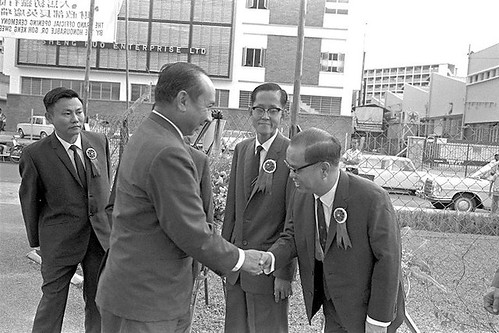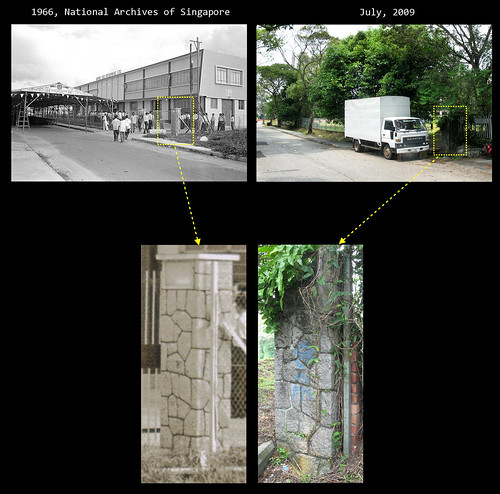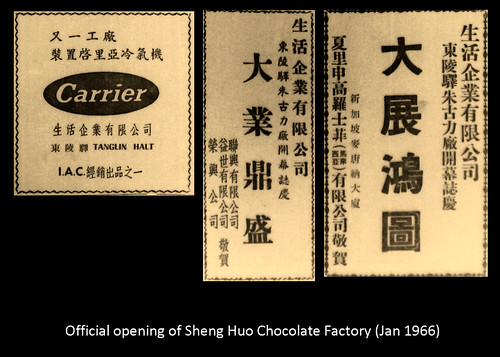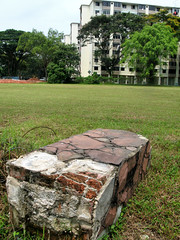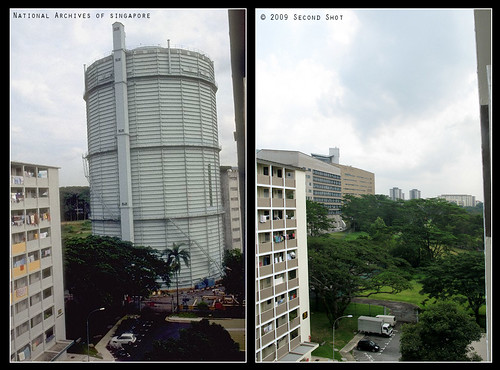I'm slowly beginning to love Tanglin Halt. It is just not your typical housing estate. I tell you why today.
Previously I blogged about a potential exploding gas tank in Tanglin Halt. This PUB gas tank stood menacingly at one corner of Queenstown Chap Lau. Towering above the 10 storey blocks, she terrorized more than a few residents and at least one visitor to the estate. Luckily she was removed during the late 90s or early 2000s before she could turn into another Chernobyl. For those who lived in fear, this was something to cheer for.
At the same corner of Queenstown Chap Lau but on a neighboring plot stood another landmark that did not give fear but joy to its resident at its inception. This was the Van Houten chocolate factory next to block 80. Living next to a chocolate factory has its privileges. From one resident,
According to my research, the Van Houten chocolate factory was next to block 80. But where exactly was it? The fact that block 80 is at the edge of the housing estate and beside the old Tanglin Halt Industrial Estate does not it any easier.
 Google Map showing Block 80 and old Tanglin Halt Industrial Estate at Tanglin Halt Road and Tanglin Halt Close.
Google Map showing Block 80 and old Tanglin Halt Industrial Estate at Tanglin Halt Road and Tanglin Halt Close.From my research, I also learned that the industrial estate had another chocolate factory. No, not Cadbury or Ferrero, but a company called Sheng Huo Enterprise. My first reaction was, who ever heard of Sheng Huo Chocolates?!
Nevertheless, I decided to embark on a 'second shot' mission to find out exactly where the two chocolate factories used to be located. I could not find any photos of the said Van Houten factory, regrettably. So my mission was focused on Sheng Huo.
Even though I can't deduce the location of Van Houten factory through various 'second shot' techniques, I decided to survey the plot of land between block 80 and Tanglin Halt Road.
Left: Taken from junction of Tanglin Halt Road and Commonwealth Drive. I think that is some road work or sewage work in the foreground. Block 80 is rightmost in the background.Right: Block 80 in background center. Taken along Tanglin Halt Road.For Sheng Huo, I was luckier. I found photos and even though I had no idea where they were taken in Tanglin Halt, I could apply the various 'second shot' techniques. These techniques work mainly because while the factories were demolished, the 10-storey Tanglin Halt flats (Chap Lau) are still standing. If you see a particular arrangement of Chap Lau in the background, that can often guide you to the photographer's location.
A simple example.
Top: From National Archives of Singapore. Old Guard Dr Goh Keng Swee officiating at factory opening, 1967. But we are more interested in what is visible in the background - Sheng Huo Enterprise Ltd. Notice the Chap Lau further back.Bottom: Today it is hard to get a good shot of Chap Lau as you go further into the industrial estate from Commonwealth Drive. In the background is block 79, similar to the Chap Lau in the 1967 photo. Tanglin Halt Road is running across.What happens if Chap Lau cannot be seen in the old photo? Suck thumb lor!
So here is the more advanced example, when Chap Lau cannot be seen. This example uses pattern matching.
Pattern matching 'second shot'. The 1966 archive photo shows the opening of Sheng Huo Enterprise Limited at Tanglin Halt Industrial Estate. Tanglin Halt Road running across in the 2009 photo. The stone pattern on both gate pillars are a perfect match. Gotcha!From just two sets of 'second shot' photos, I have established the location of Sheng Huo along Tanglin Halt Road. Of course it doesn't take a genius to come out with the 'second shot' techniques.
Just to play safe, I checked the other gate pillars to make sure they are not identical, i.e. came from the same pattern template.
Left: The other stone pillar in the 1966 archive photo.Right: Another stone pillar from the gate nearer to Commonwealth Drive.After my field trip, I did some quick research and ascertained the address of Sheng Huo Enterprise Ltd - No. 481 Tanglin Halt Road. According to
SLA map, the location could very well be where my photo were taken.
 SLA map showing possible location of chocolate factory. No. 482 is marked. I think the typical odd-even numbering is used because No. 482 is on one side whereas No. 475 and No. 479 are on the other.
SLA map showing possible location of chocolate factory. No. 482 is marked. I think the typical odd-even numbering is used because No. 482 is on one side whereas No. 475 and No. 479 are on the other.From the time I read about the name Sheng Huo, its pronunciation has been a nagging question at the back of my head. Not knowing Sheng Huo Chocolate is bad enough, I can't take it when I can't pronounce its name from the English source. Sheng Huo Enterprise sounds like a 'cina company' and the name looks hanyu pinyin. For a long time, I thought Sheng Huo is read as 盛货. Hey, don't you think this is a nice name for business?
Then I discovered i was wrong. The answer turned out to be quite amusing and unexpected. I never thought it would be that simple.
Congratulatory notices in Jan 1966 newspaper on opening of Sheng Huo Chocolate Factory at Tanglin Halt (生活企业有限公司东陵驿朱古力厂).This article started off with the Van Houten chocolate factory at Tanglin Halt which I did not manage to find. Then I found the location of Sheng Huo in near proximity to block 80. Could they be the same factory after all? Perhaps there was no Sheng Huo Chocolate and Sheng Huo actually produced Van Houten chocolates in Singapore. So the "aromatic wafts of rich chocolatey smells" described by Calvin Low came from Sheng Huo.
Fallen stone pillar from one of Sheng Huo's gates pointing to - can you believe it - block 80. Picture 1: POST (Power-on-self-test) screen of the arrival display. (5 Dec 2007)
Picture 1: POST (Power-on-self-test) screen of the arrival display. (5 Dec 2007) Picture 2: Service downtime. I'm not sure whether the system crashed or they were doing maintenance. The latter should not be done during train operating hours, right? (31 Dec 2007)
Picture 2: Service downtime. I'm not sure whether the system crashed or they were doing maintenance. The latter should not be done during train operating hours, right? (31 Dec 2007) Picture 3: My first and only experience of a disrupted service. You can read about it here. Bus bridging services ferried passengers between the two stations. I kind of regretted taking the bridge service - it took ages to reach Tanah Merah! (21 Jan 2008)
Picture 3: My first and only experience of a disrupted service. You can read about it here. Bus bridging services ferried passengers between the two stations. I kind of regretted taking the bridge service - it took ages to reach Tanah Merah! (21 Jan 2008) Picture 4: Another POST screen. So they were using Pentium III, with 20GB hard disk and 128MB of memory. You do not need powerful hardware to run a static display. But I remember such static display can show video as well, hmm .... (11 April 2008)
Picture 4: Another POST screen. So they were using Pentium III, with 20GB hard disk and 128MB of memory. You do not need powerful hardware to run a static display. But I remember such static display can show video as well, hmm .... (11 April 2008) Picture 5: Taken inside the train, maybe the NEL. Truly a 'malu' moment, but I don't really blame the developers. We know many things can go wrong. Maybe they use Windows and not Apple or Linux that's why, haha. (19 Jan 2009)
Picture 5: Taken inside the train, maybe the NEL. Truly a 'malu' moment, but I don't really blame the developers. We know many things can go wrong. Maybe they use Windows and not Apple or Linux that's why, haha. (19 Jan 2009) Picture 6: Another 'exception' message. The geek lingo implies that something has gone wrong. The message is, as usual, cryptic. (26 April 2009)
Picture 6: Another 'exception' message. The geek lingo implies that something has gone wrong. The message is, as usual, cryptic. (26 April 2009)













